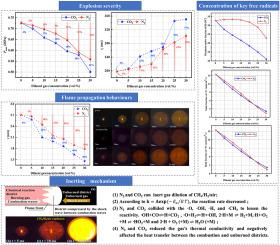Study on the effects of hydrogen addition ratio and diluent gas concentration on the explosion characteristics of methane/hydrogen gas-mixtures
IF 4.2
3区 工程技术
Q2 ENGINEERING, CHEMICAL
Journal of Loss Prevention in The Process Industries
Pub Date : 2025-08-21
DOI:10.1016/j.jlp.2025.105764
引用次数: 0
Abstract
The widespread application of CH4/H2/air mixtures in the low-carbon energy transition has elevated their fire and explosion risks to a central safety challenge. A thorough examination of the explosion behaviors of these mixtures, coupled with the implementation of effective preventive measures, is crucial to proactively prevent and minimize catastrophic accidents that could result in severe casualties. This study delved into the CH4/H2/air explosion pressure, deflagration time and flame propagation behaviours in a N2 and CO2 atmosphere via experiment and simulation. The results demonstrated that CO2 and N2 reduced the maximum explosion pressure (Pmax) by 34 % and 24 %, respectively; the deflagration time parameters were significantly prolonged with higher diluent gas concentrations. At 30 vol% concentration, CO2 and N2 decreased the flame propagation velocity by 46 % and 34 %, respectively. Additionally, CO2 exhibited remarkable inhibitory effects on the molar fractions of H•, •O and •OH radicals at a 5 vol% concentration threshold, whereas N2 required concentrations exceeding 15 vol% to achieve comparable suppression. Finally, this study concludes with a comprehensive analysis of the inerting and suppression mechanisms of N2 and CO2, examining both thermodynamic and kinetic perspectives. The research findings can provide guidelines for the safe utilization of CH4/H2 mixtures and facilitate the industrialization of hydrogen energy applications.

加氢比和稀释气体浓度对甲烷/氢气混合物爆炸特性影响的研究
CH4/H2/空气混合物在低碳能源转型中的广泛应用,将其火灾和爆炸风险提升到一个核心的安全挑战。彻底检查这些混合物的爆炸行为,再加上实施有效的预防措施,对于主动预防和尽量减少可能导致严重伤亡的灾难性事故至关重要。本研究通过实验和模拟研究了CH4/H2/空气在N2和CO2气氛下的爆炸压力、爆燃时间和火焰传播行为。结果表明:CO2和N2分别使最大爆炸压力(Pmax)降低34%和24%;随着稀释气体浓度的增加,爆燃时间参数明显延长。在30 vol%浓度下,CO2和N2分别使火焰传播速度降低46%和34%。此外,在5 vol%浓度阈值下,CO2对H•、•O和•OH自由基的摩尔分数表现出显著的抑制作用,而N2需要超过15 vol%的浓度才能达到类似的抑制效果。最后,本研究从热力学和动力学的角度全面分析了N2和CO2的惰化和抑制机制。研究结果可为CH4/H2混合物的安全利用提供指导,促进氢能应用的产业化。
本文章由计算机程序翻译,如有差异,请以英文原文为准。
求助全文
约1分钟内获得全文
求助全文
来源期刊
CiteScore
7.20
自引率
14.30%
发文量
226
审稿时长
52 days
期刊介绍:
The broad scope of the journal is process safety. Process safety is defined as the prevention and mitigation of process-related injuries and damage arising from process incidents involving fire, explosion and toxic release. Such undesired events occur in the process industries during the use, storage, manufacture, handling, and transportation of highly hazardous chemicals.

 求助内容:
求助内容: 应助结果提醒方式:
应助结果提醒方式:


